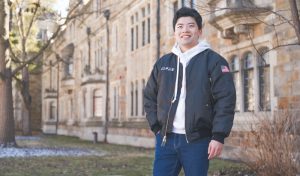by Joan Bivins
Manalapan, N.J.
My sister, Jeanne, who has lived with me for 35 years and keeps an old habit of leaving paper towels on the counter, was the first to tell me how much I had changed. In 2015, a year into my Buddhist practice, I called one of these towels to her attention. She told me to let it go … and I did. That’s when she said it.
“Joanie, I cannot believe you let that go just now. Lately, I cannot believe I’m talking to the same person.”
That may seem insignificant, but finding the practice of SGI Nichiren Buddhism at age 73 fulfilled nothing less than a lifelong search for a spiritual practice that would help me soften to the people around me. Attempts along this line trace back to childhood: At the age of 9, I announced to my mother that I would become a nun, my ideal of a bighearted person.
“A bossy nun, I guess,” she said.
With my father working, she had her hands full with us kids and let me, the eldest, get things done the way I knew how—by whipping around like a whirling dervish, doing all but the cooking, bossing my five bookish siblings to roll up their sleeves. I did not like the role, but it was my duty, I felt, to play it; someone had to or the place would go to seed. I could be relied on to get the troops marching, but I was high-handed and disconnected from kindness and trust, the proper wellsprings of service. Instead, obligation and worry drove my service to others.
While I would go on to get married, have kids and do all that generally disqualifies girls from becoming nuns, I would, indeed, become a Presbyterian deacon and raise my children as regular churchgoers. While I did manage to sell them on their duty to attend church, it was like dragging horses to water; as soon as they left for college, they stopped. Not long after my youngest left home, my own faith, affirmed increasingly in terms of duty, reached an impasse. I was in my mid-60s, a deacon of some 40-odd years, but I had felt unsupported and strained in my efforts to connect my heart with the hearts of others. Despite intense misgivings, I left the church in 2008.
The years that followed were hard. Though a teacher by trade, a shortage of administrators at my school required me to take on duties that befitted a vice principal. I continued to find meaning in work, but the demands made of me, beyond my pay and field of expertise, caused me greater anxiety than ever.
When, attending the wedding of extended family in 2014, I heard the chanting of Nam-myoho-renge-kyo sounding from a living room, I was immediately curious. The resounding, melodious rhythm filled the house for a half-hour.
At dinner, I asked my brother-in-law about the chant. He had broached the topic with me once before, but I had let it go. Now, patiently, he explained about the SGI and its central practice: the chanting of Nam-myoho-renge-kyo as a celebration of the Buddha nature inherent within all people. He traced the organization’s history, from the teachings of Nichiren Daishonin up to their present expression within the SGI, comprising people committed to peace the world over.
He gave me a card reading Nam-myoho-renge-kyo, which I taped on my computer monitor at work. Whenever things piled up and threatened to spin beyond my control, I chanted under my breath, which calmed me down and allowed me to keep a level head and accomplish much more than I normally could. I also began taking part in district meetings and studying with the other Many Treasures Group women, whom I came to regard as my bodhisattva sisters in faith. My sister, Jeanne, was the first to comment on my change, but soon siblings, friends, children and grandchildren were piping up.
My daughter, who had never asked me to pray for her before, took to ringing me up when problems arose, asking me to chant. My son, overjoyed that I would be published in a Buddhist newspaper, asked if I thought his son might connect with the practice. And when I ask my grandkids, three of whom attended the Lions of Justice Festival in 2018, if they’d like to join me for an SGI activity, they most often say, “Definitely,” “Yes!” or “I’ll go!”—responses I never got from my kids at that age. No finger shaking, no pushing; they want to.
The reason, I think, is that they can see it in me, the joy of this kind of service. In 2016, my bodhisattva sisters and I took my eldest granddaughter to her first meeting, a kosen-rufu gongyo meeting at the East Orange Buddhist Center, and my first of that size. When we got there, the first thing that struck me was the diversity. Everybody together. Everybody chanting. They didn’t know me, but they all greeted me, smiling at me, thanking me with everything they had for the long drive we’d made. And afterward, you could see it in the room: the joy. It was in the way people spoke to one another and really listened. I actually cried some. It was humbling, somehow, and I could tell that my granddaughter was moved, too. More than anything, I decided I wanted to leave to my children and grandchildren, family and friends, a legacy of the spirit in that room, of voluntarily giving of ourselves, the best of ourselves, not out of duty, but joy.
You are reading {{ meterCount }} of {{ meterMax }} free premium articles





